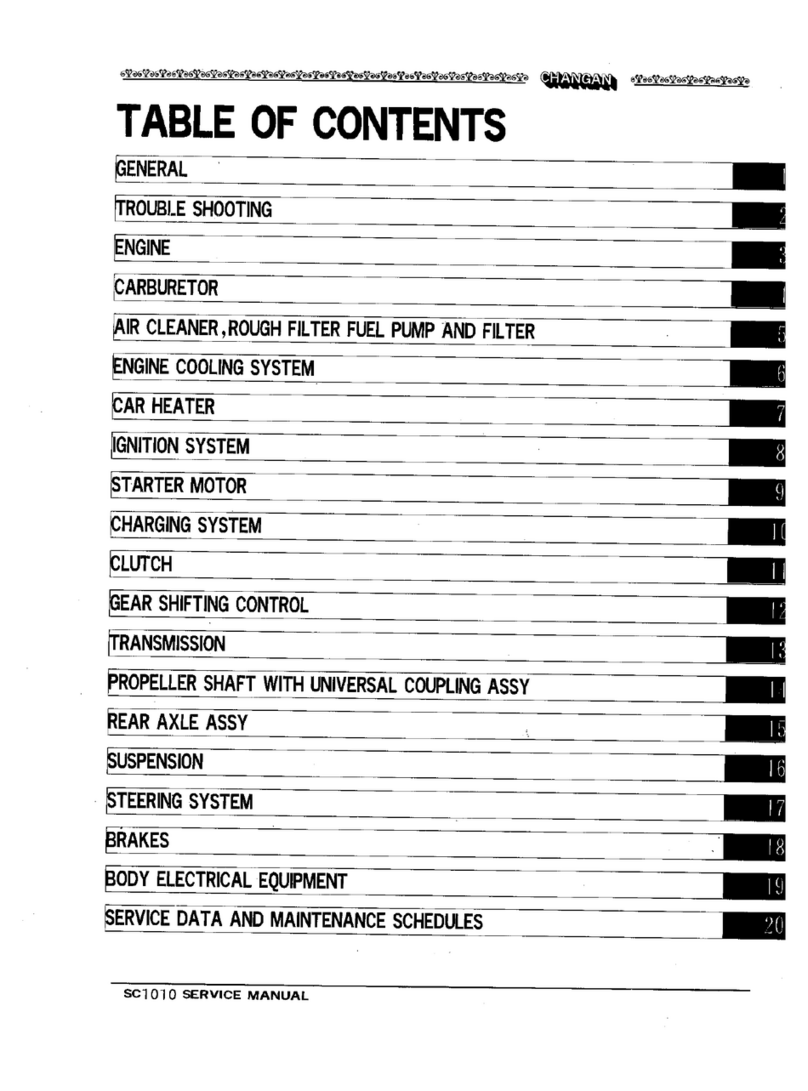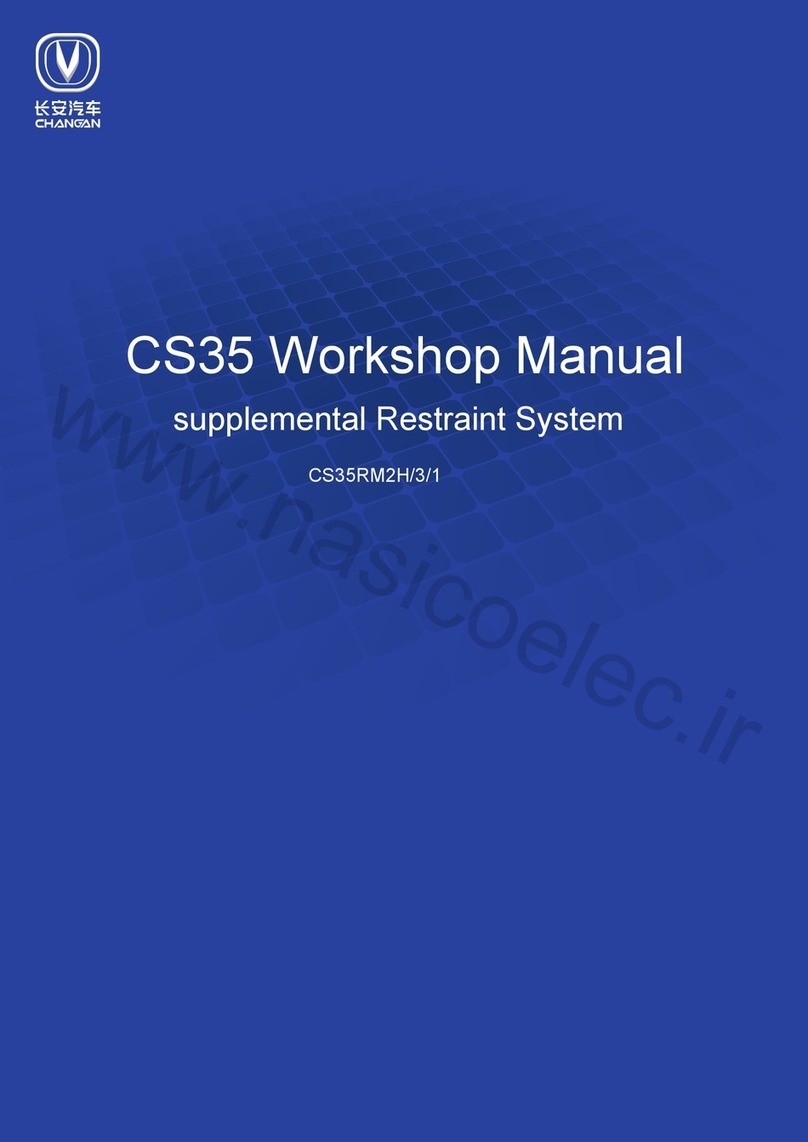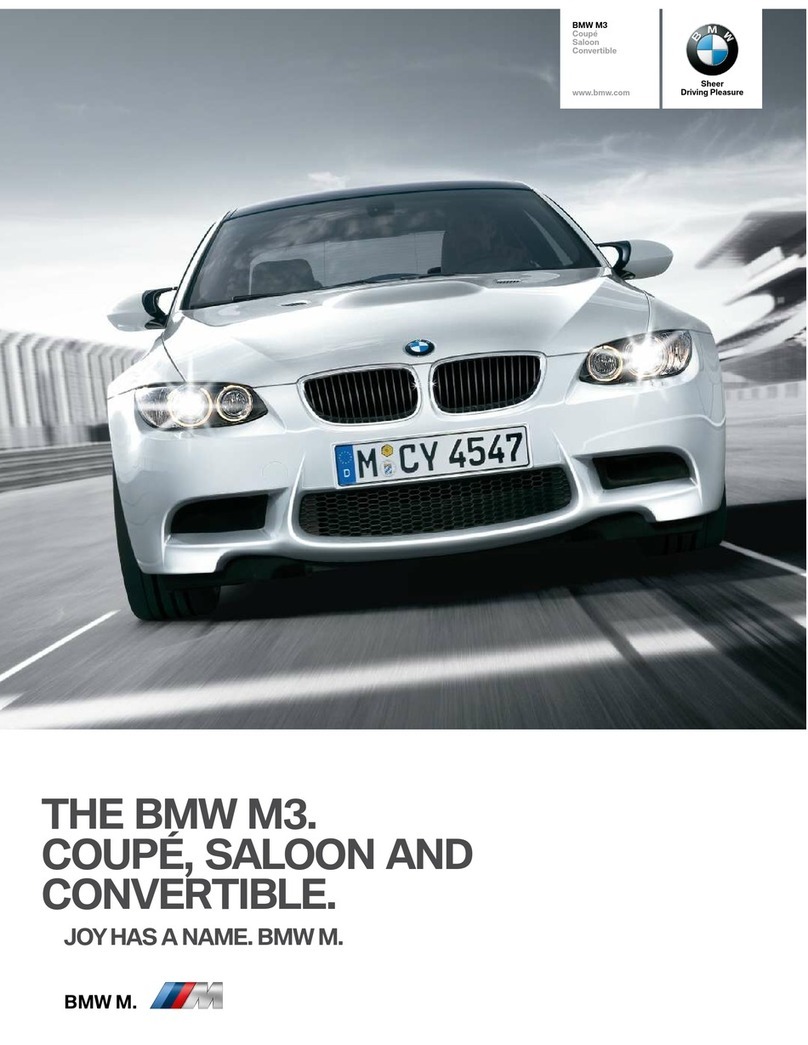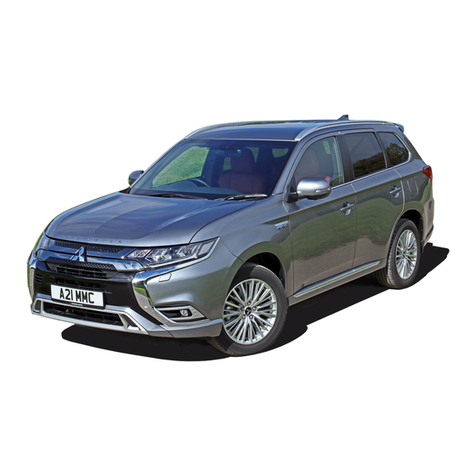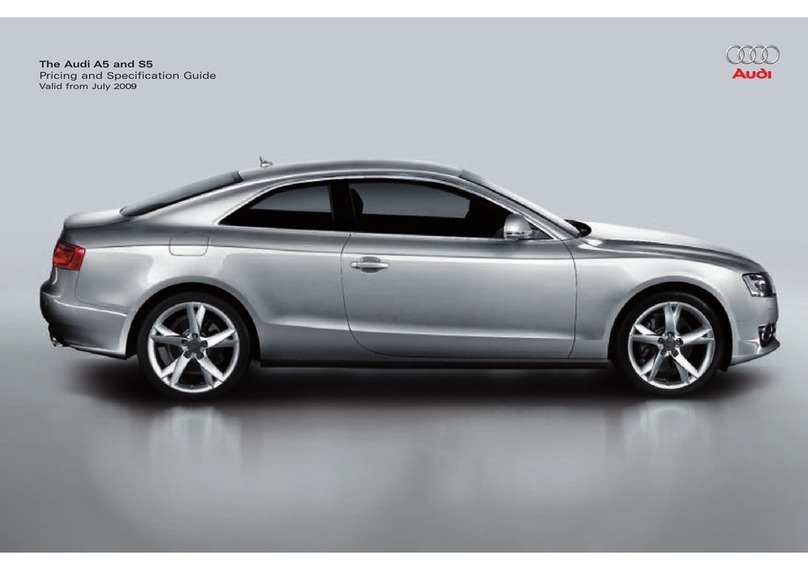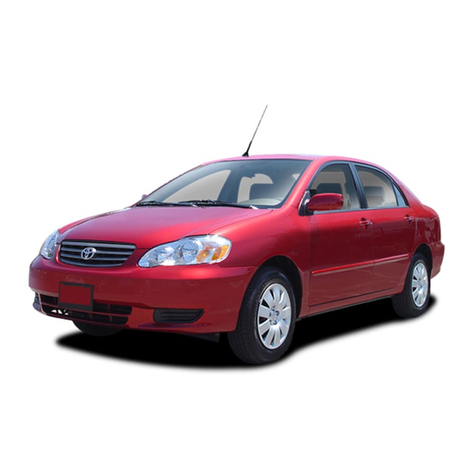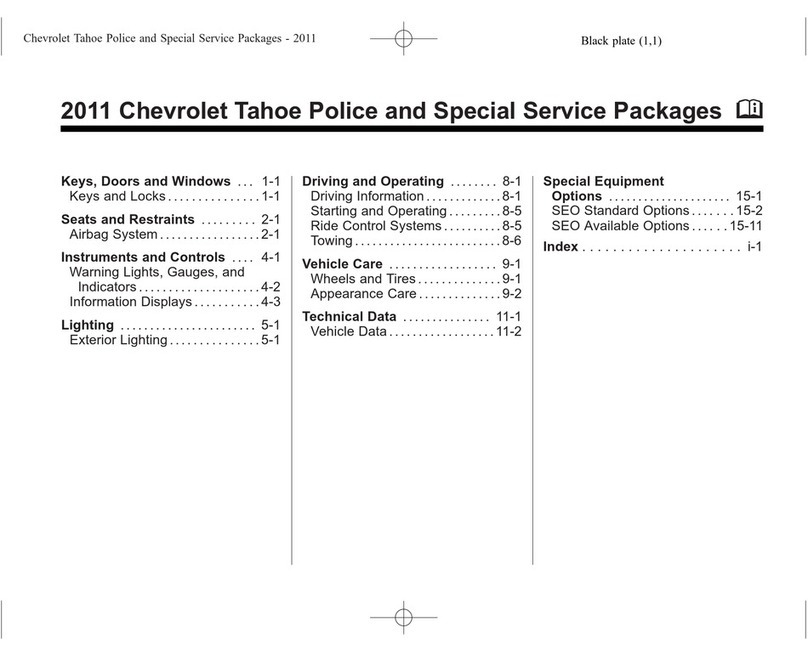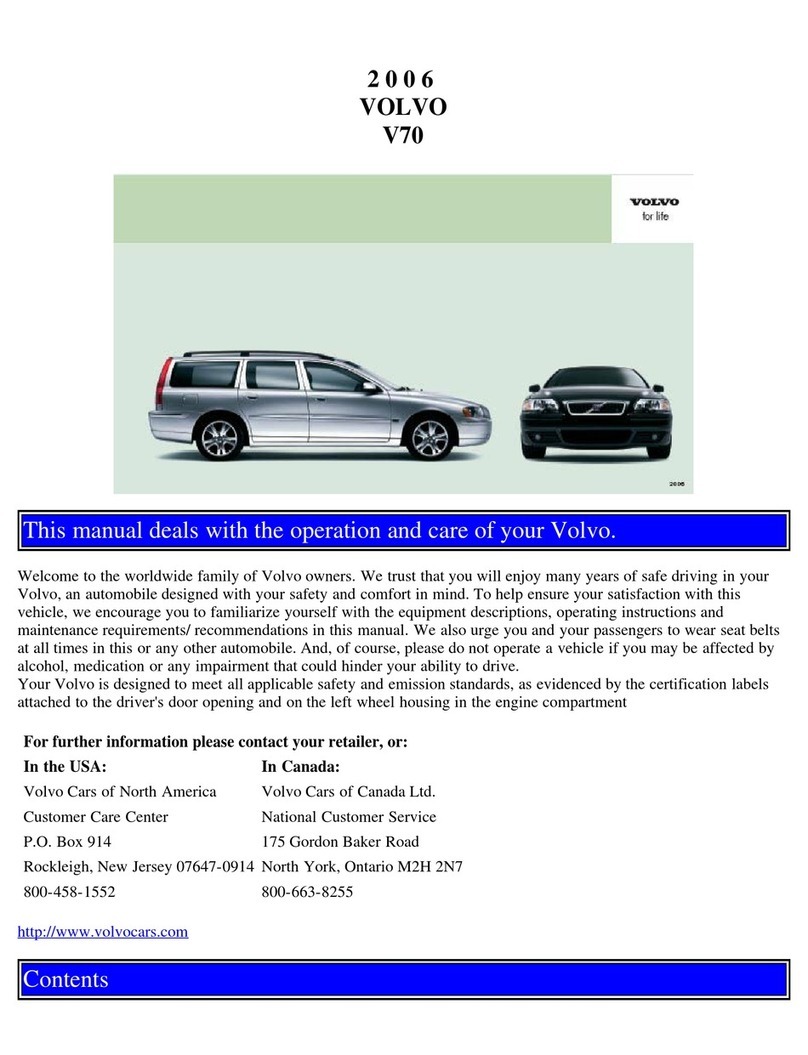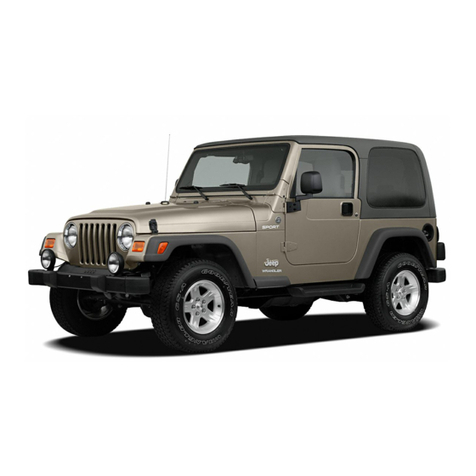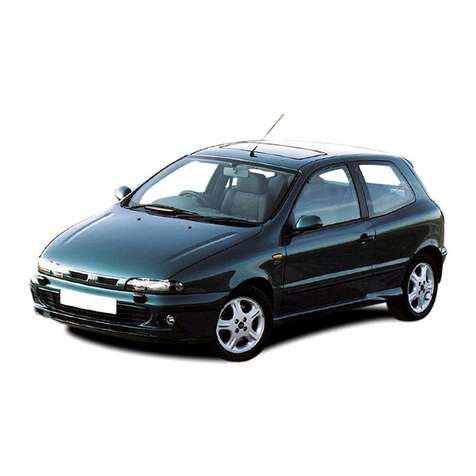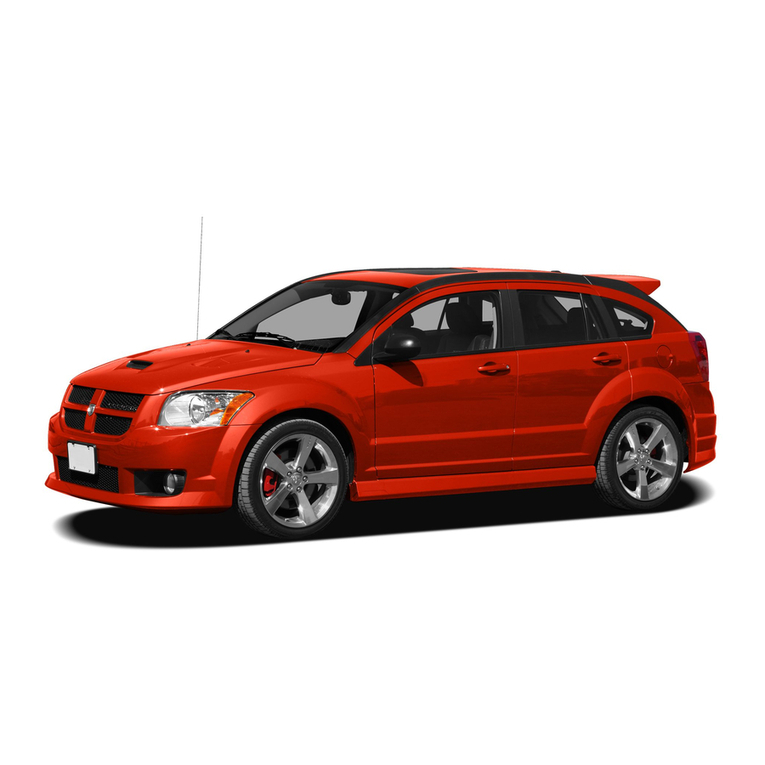Changan BENNI MINI 2011 User manual

2011
BENNI MINI SERVICE MANUAL
2011 Changan Automotive Co., Ltd.
Copyright ©
Information up to Nov 2011.
Without written permission, any form of duplicate, storage or distribution (including, but not limited to, electronic copying, photocopying,
scanning and recording) of any part of this manual is not allowed. This statement applies to all texts, figures and tables.
This service manual consists of BENNI MINI repair information


Maintenance Manual of BENNI-MINI


100-00-1 Overview
100-00-1
Section 100-00 Overview
Contents Page
Instruction and Operation
About the Manual ............................................................................................................................................ 100-00-3
Brief Introduction ............................................................................................................................................ 100-00-4
Spare Parts Substitution................................................................................................................................... 100-00-3
Special Tools ................................................................................................................................................... 100-00-3
Important safety instruction............................................................................................................................. 100-00-3
Warning, Caution and Prompting.................................................................................................................... 100-00-4
How to Use the Manual ................................................................................................................................... 100-00-3
Examples ......................................................................................................................................................... 100-00-4
Precautions of Health and of Safety................................................................................................................. 100-00-5
Brief Introduction ............................................................................................................................................ 100-00-5
Acid and Alkali Metals.................................................................................................................................... 100-00-5
Safety Air Bag ................................................................................................................................................. 100-00-5
Air-conditioning Cooling Agent...................................................................................................................... 100-00-6
Sealing Agent and Adhesive Agent................................................................................................................. 100-00-6
Anti-freezing Fluid .......................................................................................................................................... 100-00-6
Electrolyte........................................................................................................................................................ 100-00-7
Clutch Plate and Brake Shoe ........................................................................................................................... 100-00-7
Braking Fluid................................................................................................................................................... 100-00-7
Braze Welding................................................................................................................................................. 100-00-7
Chemical Substance......................................................................................................................................... 100-00-7
Clutch Oil ........................................................................................................................................................ 100-00-8
Clutch Friction Disc and Friction Lining......................................................................................................... 100-00-8
Corrosion Preventing Material......................................................................................................................... 100-00-8
Cutting............................................................................................................................................................. 100-00-8
Paraffin Removal............................................................................................................................................. 100-00-8
Dust.................................................................................................................................................................. 100-00-8
Electric Shock.................................................................................................................................................. 100-00-8
Engine Oil........................................................................................................................................................ 100-00-8
Exhaust Gas..................................................................................................................................................... 100-00-8
Acoustic Insulation Fiber................................................................................................................................. 100-00-8
Fire Prevention................................................................................................................................................. 100-00-9
First Aid........................................................................................................................................................... 100-00-9
Foam-polyurethane.......................................................................................................................................... 100-00-9
Cooling Agent.................................................................................................................................................. 100-00-9
Fuel.................................................................................................................................................................. 100-00-9
High Pressure Cylinder.................................................................................................................................... 100-00-9
Gas................................................................................................................................................................... 100-00-9
General Purpose Maintenance Tool / Device .................................................................................................. 100-00-10
Testing Device for High Pressure Air, Lubricating Oil and Oil Fluid............................................................. 100-00-10
Legal Affairs.................................................................................................................................................... 100-00-10
Lubricating Oil and Lubricating Grease .......................................................................................................... 100-00-10
Noises............................................................................................................................................................... 100-00-10
Acoustic Insulation Material ............................................................................................................................ 100-00-10
Paints .............................................................................................................................................................. 100-00-10
Pressure Device................................................................................................................................................ 100-00-11
Solder ............................................................................................................................................................... 100-00-11
Solvent.............................................................................................................................................................. 100-00-11
Suspended Load ............................................................................................................................................... 100-00-11

100-00-2 Overview
100-00-2
Sealing on Vehicle Base................................................................................................................................... 100-00-11
Soldering .......................................................................................................................................................... 100-00-11
Warning Signs on Vehicle................................................................................................................................ 100-00-12
Petroleum Solvent Oil...................................................................................................................................... 100-00-13
Standard Workshop Operating Manual ............................................................................................................. 100-00-14
Vehicle in the Maintenance Workshop ............................................................................................................ 100-00-14
Vehicle Traction............................................................................................................................................... 100-00-14
Connect the Auxiliary Battery with the Jumper Wire ...................................................................................... 100-00-14
Component Cleaning........................................................................................................................................ 100-00-15
Calibration of the Important Measuring Equipment......................................................................................... 100-00-15
Solvent, Sealing Agent and Adhesive Agent.................................................................................................... 100-00-16
Brief Introduction............................................................................................................................................. 100-00-16
General Specifications...................................................................................................................................... 100-00-16
Test of Road or Rolling Testing Platform........................................................................................................ 100-00-17
Check before Testing........................................................................................................................................ 100-00-17
Engine Starting................................................................................................................................................. 100-00-17
Test of Road or Rolling Testing Platform........................................................................................................ 100-00-17
Braking Test..................................................................................................................................................... 100-00-18

100-00-3 Overview
100-00-3
Instruction and Operation
DESCRIPTION AN D OPERATION
About the Manual
Brief Introduction
The compiling format of this manual aims to satisfy
the requirements of the maintenance skill men, and
this manual provides the general instructions for
completing the service and maintenance. The
reliability of the work can be enhanced according to
the maintenance specified in the manual.
Spare Parts Substitution
The
maintenance fittings of Chang’an Automobile
Company Limited are manufactured according to
the original factory standard. Thus, when the
maintenance service is performed, only the original
maintenance fittings manufactured by Chang’an
Automobile Company Limited can be used.
Special Tools
All the special tools required by the maintenance
every time are provided in the Special Tool List
before every procedure. Moreover, when necessary,
illustrations are additionally provided for the
identification of these special tools.
The special tools can be ordered from Chang’an
Automobile Company Limited.
Important Safety Instruction
Suitable maintenance methods and correct
maintenance procedures are vital for the operation
reliability of all vehicles and the safety of the
maintenance personnel.
This manual can not foresee all circumstances and
provide the relevant warning and suggestions.
Anyone who does not follow the instructions in this
manual must identify that the selected maintenance
method, tool and parts can not endanger the
personnel safety and the automobile integrity.
Warning, Caution and Prompting in the Manual
Warning: used for indicating the possible
personnel injury if the Manual is not
observed.
Caution: used for indicating that the
vehicle and the applied maintenance
device can be damaged if the operation is
not carried out according to the
appropriate procedures.
Prompting: used for providing other information
for the complete and satisfied maintenance service.
When reading this manual, you may encounter the
signs of “Warning”, “Cautious” and “Prompting”.
The signs of “Warning”, “Caution” and
“Prompting” are provided at the beginning of each
step.
How to Use the Manual
The descriptions in this manual are given in the
form of sections, and the sections of the specific
system are gathered in the relevant chapters.
Each chapter gives a brief description of a specific
part of automobile. This manual is divided into five
chapters: Overview, Chassis, Power Steering
System, Electricity, Vehicle Body and Coating.
Page numbers of all the chapters and sections are
provided in the first page of this manual. Each
chapter includes the contents of Overview,
Introduction and Operation and Maintenance
Adjustment and Check.
If the parts need to be dismounted or disassembled
according to instruction or sequence, the splitting
procedures with the corresponding diagrammatic
drawing and description are provided and are noted
in sequence. (Please see Example.)
The left and right sides of vehicle are determined
by looking forward form the driver seat position.
The left and right sides of the engine are
determined by looking towards the front end belt of
camshaft from the flywheel.
Inspection and Identification
This chapter comprises the Visual Inspection Table,
Failure Phenomenon Table, other information table
(such as Diagnosis Procedures) and Supplemental
Testing Procedures and Technical Standards or
Specific Testing Procedures which guides the
mechanic how to perform.
Failure
Phenomenon Table
This table is used for indicating the failure
phenomenon, causes and diagnosis procedures
under some certain circumstances.
Fixed Point Test
As for the electric failure, the causes of the failure
should be gradually identified according to the
logical procedures by referring to the Fixed Point
Test Table. The Fixed Point Test Table comprises
two columns: Inspection Items and Concrete
Procedures/ Results/ Measures.
Many diagrams and icons (with or without titles)
are shown in the column Inspection Items. The
explanatory notes concerning the test procedures or
the special handling measures are provided in the
Concrete Procedures/ Results/ Measures.
The number marks are used for indicating the serial
numbers of inspection items.
Component Testing
When some step is over complicated and therefore
can not be arranged in the signal page fixed point
test or a plurality of fixed point tests require to
measure one identical component, the component
testing should be performed.

100-00-4 Overview
100-00-3
Instruction and Operation
Illustration Indication
The testing diagram shows the required
measurement or test in some certain testing
procedure.
The typical test diagram is suitable for the use of a
voltage gauge and an ampere meter.
When a signal diagram shows the multi-step test,
the solid line draws the conducting wire until the
multi-step measured conducting wire branch points,
and the conducting wire of multi-step measuring
points after the branch point should adopt the dotted
line.
The double circle testing pin is used for indicating
the disaster box type instrument. The testing pin
should be labeled with pin number.
Examples
When the special tool is required, its figure and use
method will be provided, or the tool number will be
listed. The preset torque value will be given at the
corresponding position in the procedures.

100-00-5 Overview
100-00-3
Instruction and Operation
Precautions of Health and of Safety
Brief Introduction
Many operations in connection with the service and
maintenance of the vehicle will threaten and
endanger the human health. Plenty of dangerous
operations and its relevant dangerous articles and
equipment are listed below in the alphabetical
(English) order. Please pay special attention to the
following dangerous articles.
Listed contents are not always complete, therefore
the safety and health should be always considered
first during the practical operation.
Before the use of any product, the safety
specification table of the material supplied by the
manufacturer or the supplier of the products should
be firstly consulted.
Acid and Alkali Metals
See Section Electrolyte.
Such as corrosive soda ash or sulfuric acid.
Electrolyte and cleaning material.
Irritable and corrosive substances to skins, eyes,
noses, throats and clothes, inflammable articles and
substances which can damage the normal protection
clothes.
These substances should be avoided from splitting
on skin, eyes and clothes. Suitable protective
overall, gloves and glasses should be worn. Never
inspire the acid fume.
Eye washing bottles, water taps and soaps are
positioned nearby for the use at ay time when
unexpected accident happens.
Signs of Harmful to Eyes shall be placed.
Safety Air Bag
See Section Inflammable Chemical Substance.
Inflammable and Explosive Substance--observance
of the non-smoking regulation.
The safety air bag is installed on the instrument
panel before the steering wheel and passenger(s) for
protecting the life safety of driver and passengers.
Highly explosive substance is contained in the
safety air bag, and when the substance is ignited,
gases of high temperature and high pressure
(2500°C) will be generated.
The gas generating agent used for the air bag is
sodium azide. The sodium azide is sealed in a
module and can be fully released when the air bag
is extended. Never try to open the air bag by
yourself, or the sodium azide will be exploded. If
the gas generator is broken, the complete protective
working clothes must be worn during the treatment.
After the air bag is normally extended, the
protective gloves and glasses must be worn on site
during the treatment.
The used safety air bag should be packed by
using the plastic bags according to the local
regulations strictly and then discarded at the
designated disposal site for chemical waste.
If directly contact with the generated gas, please:
– Use water to thoroughly clean the site
(affected area).
– Seek medical assistance if necessary.
Air Bag--operations which shall be performed
– Position the air bag vertically.
– Keep the air bag dry.
– The unsealed face shall be toward the human
body when the air bag is carried.
– The sealed side of the air bag should be placed
upwards.
– Carefully inspect whether the air bag is
damaged.
– Stand at the side face when the air bag is
connected.
– Identify that all the testing devices have been
correctly calibrated and maintained.
– Clean both hands when the expanded air bag is
carried away.
Air Bag--operations which shall be forbidden
– It is forbidden to place the inflammable
substance or gas generator together with the air
bag.
– The storage temperature of gas generator can
not be more than 80°C.
– The air bag can not be inversed.
– It is forbidden to open the housing of gas
generator.
– It is forbidden to place the gas generator near
open fire or heat source.
– It is forbidden to position any object on the air
bag.
– It is forbidden to use the damaged air bag.
– It is forbidden to contact the air bag and the gas
generator after they are burnt in ten minutes.
– It is forbidden to use the electricity meter probe
on the air bag circuit.

100-00-6 Overview 100-00-6
Description and Operation (Continued)
Air-conditioning Cooling Agent
See Section Chemical Substance.
Inflammable substance—observance of the
non-smoking regulation
Frostbite can be caused when the cooling agent is
contacted with skin.
The manufacturer’s guidance must be strictly
observed. The protective gloves and glasses can
avoid the strong light exposure.
If the cooling agent is inadvertently contacted with
skins or eyes, please wash with water immediately.
The suitable cleaning agent should be used to wash
if the cooling agent is split into the eyes, never rub
your eyes. Seek medical assistance if necessary
Air-conditioning Cooling Agent—forbidden
items
– It is forbidden to expose the air-conditioning
cooling agent under sunshine or heat the
air-conditioning cooling agent.
– When the cooling agent is filled, never position
the filling bottle vertically, and the filling
opening should be positioned downwards.
– Prevent the frostiness on the air-conditioning
cooling agent bottle.
– Prevent the dropping of the air-conditioning
cooling agent bottle.
– It is forbidden to vent the air-conditioning
cooling agent under any circumstances.
– It is forbidden to use the cooling agent in a
mixing way, such as fluorine R12 and R134a.
Sealing Agent and Adhesive Agent
See Chapter Inflammable Chemical Substance.
Inflammable Substance--observance of the
non-smoking regulation.
In general, the sealing agent and the adhesive agent
should be placed in the non-smoking area and must
be preserved cleanly, for example, put the sealing
agent and the adhesive agent on the storage rack
covered by disposable paper towel, it is advisable
that the sealing agent and the adhesive agent are
taken out of the package boxes to position them
separately; the package boxes include subpackage
boxes on which corresponding labels should be
applied.
For melting and sealing agents and adhesive
agent, see Section Melting Agent
Follow the instruction book of the manufacturer.
Water Soluble Sealing Agent and Adhesive
Agent
The water soluble viscose glue based on
macromolecule emulsion and latex may contain
small amount of volatile toxic substances and
chemicals harmful for human body. Avoid making
the substances contact with eyes and skins, please
make sure good ventilation when the water soluble
viscose glue is used.
Hot Melt Viscose
The solid hot melt viscose is safe. Under the molten
state, the hot melt viscose can be burnt and will
release harmful gases, therefore being harmful to
health.
Wear suitable protective working overalls, use a
constant temperature heater with self-deenergizing
function, and enough air drafting equipments
should be provided.
Resin Sealing Agent and Adhesive Agent, such
as Epoxide and Formaldehyde Resin
The adhesive agent should be mixed in the places
of good ventilation because harmful or toxic
volatile substances will be released during mixing.
Dermatitis can be caused when the skin contacts
with the tacky resin and hardening agent, some
harmful and toxic chemical substances will be
absorbed by skin.
The spatters can injure eyes.
Keep good ventilation and avoid contacting with
skins and eyes.
Anaerobic Cyan Acrylate Adhesive and Acrylic
Acid Adhesive
Most of the adhesive has irritation, causes the
irritability or the damage to the skin and the
respiratory tract. Some of them have strong
irritation to eyes.
Avoid such substances contacting skin and eyes and
follow the instruction book of the manufacturer.
Forbid the cyan acrylate adhesive to contact
with skin and eyes. If contact for carelessness,
please put the clean and wet cloth immediately

100-00-7 Overview 100-00-7
Description and Operation (Continued)
or go to hospital. Forbid to touch the wound
position by hands. Select the places of well
ventilation because the steam will stimulate
eyes and nose.
Isocyanate (Polyurethane) Sealing Agent and
Adhesive Agent
See Resin Adhesive.
Any person suffering asthma and other
respiratory system diseases can not touch or
close to such substances.
Excessively exposing such substances will
stimulate eyes and the respiratory system. If the
concentration is over high, the substances will
stimulate the nervous system, and will make
the person lose consciousness in the severe
situation. Touching such substance for a long
time will influence the good health.
Touching with the skin for a long time will
stimulate skin, and will cause the dermatitis
when the situation is severe. If entering into
eyes, the eyes will be hurt.
Any sprinkling action must be performed in the
places of well ventilation, and the steam and
the sprinkled grains shall be far away from the
respiratory area.
Wear the proper the gloves, the glasses and the
respirator.
Anti-Freezing Fluid
See Section Combustibles and Melting Agent.
The anti-freezing fluid includes isopropanol,
ethylene glycol and methanol.
High inflammable, inflammable and combustible.
Solutions used in the automobile cooling system
and the water spraying system of wipers.
The anti-freezing fluid will generate the steam
when being heated. Avoid inhale such gas.
The anti-freezing fluid or other harmful materials
may enter into the human body through the skin. If
the anti-freezing fluid is drunk for carelessness, it
may cause the deadliness, and the person must go to
hospital immediately.
Forbid to use any of such substances in the cooling
or industrial water use system related to the food
manufacturing or drinking system.
Electrolyte
Please see Section Acid and Alkali Metal
simultaneously.
When the battery cell is charged, the released gas
will cause explosion. Forbid to use the open fire or
the mars when the battery cell is charged.
Ensure good ventilation.
Braking Fluid
Please see Section Fire Prevention.
If the braking fluid is splashed on skin and eyes,
there will have slight stimulus. Possibly avoid the
braking fluid touching skin and eyes. Because the
steam pressure is lower, the harmful steam can not
be inhaled at normal temperature.
Braze Welding
See Section Welding.
Chemical Substances
See the contents of the laws and regulations.
The chemical substance includes melting agent,
sealing agent, adhesive, paint, resin foam,
electrolyte, anti-freezing agent, braking fluid, fuel,
oil and grease. Be careful when use and store the
substance. They may be noxious, harmful, and has
corrosive irritability and are inflammable and will
cause generate some harmful gas and dust.
If the chemical substance is exposed for a long time,
the human health will be influenced to different
extents.
Chemical Substance--operations which shall be
performed:
– The labels on the dangerous articale vessel and
the corresponding promotion information and
instruction book shall be carefully read to
obtain the relevant safety information. The
safety and health data table of the substance
can be obtained from the manufacturer.
– If being polluted by the chemical substance,
the skin and clothes shall be cleaned in time.
Replace the severely polluted clothes and
clean them.
– The operation regulation shall be compiled, and
wear the protective clothes to avoid the
substance polluting skin and eyes, avoid
inhaling the harmful gas, acid mist, dust and

100-00-8 Overview 100-00-8
Description and Operation (Continued)
smog, etc. and avoid the combustion and
explosion caused by such substance.
– Clean hands immediately after touching the
substance.
– The working area shall be kept clean and tidy
without leakage.
– The chemical substance shall be managed and
stored strictly in accordance to the national
and local regulation.
– Avoid the children touching.
Chemical Substance--Forbidden Operations:
– Forbid to mix the chemical substance arbitrarily
without following the manufacturer’s guiding.
Mixing some chemical substances will
generate the harmful substance; the noxious
and harmful gas will be released or the
explosion occurs.
– Forbid to spray the chemical substance in the
narrow space, such as in the automobile with
persons, especially to spray the melting agent
chemicals.
– Forbid to heat or burn the chemical substances
arbitrarily without following the
manufacturer’s guide, some chemical
substances are combustible, and some
substance will release the noxious or harmful
gas when burnt.
– Do not openly put the vessel, the gas emitted
in the vessel will cause the poison to the
human body or cause the explosion. Some
gases lighter than air will accumulate in the
small section.
– Do not transport the chemical substances with
the vessel without being labeled.
– Forbid to wash hands or clothes with the
chemical substances. The chemical substances,
especially the melting agent and fuel will
make the skin dry, and also stimulate the skin
to catch dermatitis, or the hands or clothes
will absorb some noxious and harmful gas
through the skin.
– Forbid to store other articles with the empty
tank which once used to store the chemical
substance without the special treatment.
– Do not smell the chemical substance. The
sudden gases of high concentration will cause
the poisoning or cause the injury.
Clutch Oil
See Section Braking Fluid.
Corrosion Preventing Material
Please see Sections Melting Agent and Fire
Prevention simultaneously.
Because the corrosion preventing material belongs
to the inflammable substance, please follow the
regulation of No Open Flames.
Because the substance has various types, please
follow the instruction book of the manufacturer.
The melting agent, the resin or the product oil may
be contained in the substance. The substance shall
be avoided touching skin and eyes. The substance
can not be sprayed in the enclosed space and only
can be sprayed in the conditions of well ventilation.
Cutting
Please see Section Wielding.
Wax Removal
See Section Melting Agent And Fuel (Kerosene).
Dust
The dust may be poisonous and stimulate the
human skin. Avoid inhaling the ash of the powder
chemical substance or other ashes. Wear the
respirator when the air is not smoothly circulated.
The extra fine dust of the inflammable material will
cause the explosion. The explosive threshold and
ignition source shall be avoided.
Electric Shock
Incorrectly using or using the electrical equipment
with defects will cause the electric shock.
The electrical equipment shall be regularly detected
and the equipment shall be ensured to be perfect.
The equipment with defects shall have the clear
label and be removed from the working area.
Ensure that the conducting wire, the cable, the
plug and the socket have no abrasion, knotting,
cutting, cracking or other damages.
Do not make the electrical equipment and the
electric wire contact with water.
Ensure that the electrical equipment is
protected by the fuse.
Correctly use the electrical equipment and do
not use the device with problems, and violation of
this operation will cause the fatal danger.

100-00-9 Overview 100-00-9
Description and Operation (Continued)
The electric wire of electric appliance shall be
ensured not to be intercepted or damaged when the
automobile is hoisted.
Ensure that the electrician be trained in first aid.
If electrically shocked:
– Cut off the power source before touching the
electric shocker.
– If the power source can not be cut off, use the
dry and non conducting materials to push away
the sufferer or draw the sufferer away the
power source.
– Perform the cardio-pulmonary resuscitation
immediately.
– Seek the medical help.
Engine Oil
Please see Section Lubricating Oil and Grease.
Waste Gas
The waste gas includes the noxious, harmful
and smothering chemical materials, such as
carbon monoxide, nitrogen monoxide,
acetaldehyde, aromatic hydrocarbon and lead
containing gas, etc. The engine can only be
started after the waste gas is discharged or in
the places of air circulation.
Gasoline Engine
The gasoline engine has no symptom before
generating the noxious and harmful gas. The harm
of the noxious and harmful gas can be immediate
and also can be latent.
Acoustic Insulation Fiber
See Section Dust.
The acoustic insulation fiber is used for insulating
the sound and the noise.
The cellulose and the cutting scrap will cause the
skin stimulation. This is often the physical effect
but not the chemical reaction.
The working practice guide must be complied, and
the gloves must be worn to avoid the substance
contacting with the skin for a long time.
Fire Prevention
See Welding, Foam and Legal Affairs.
Most of the substances related to the automobile
maintenance are the inflammable substances. The
noxious or harmful gas can be released when some
of them are burnt.
When the inflammable substances or the melting
agents are stored or used, especially when welding
or being close to the electrical equipment, the fire
safety shall be strictly noted.
Before using the welding device or the heating
device is used, ensure that there are no
combustibles around, and place the extinguisher
nearby.
First Aid
Besides meeting the legal requirements, the
maintenance workshop must be equipped with the
personnel who have been trained for first aid.
After any substance is sprayed in eyes, the eyes
must be washed for at least ten minutes with clean
water.
After polluted by the chemical substance, the skin
shall be washed with water and the toilet soap.
Wash and cool with cold water immediately after
burnt by some substances.
If inhale the dust, go to the places with fresh air
immediately. If this method does not take effect,
please send to the hospital immediately.
If drink some liquid for carelessness, please go to
hospital immediately and say the name and
composition of the liquid. Do not try to vomit
unless there has special instruction on the label.
Foam - polyurethane
See Section Fire Prevention.
The foam is used for isolating the sound and the
noise. There are also foams in the seat and the
shock absorber.
Operate by strictly following the instruction book
of the manufacturer.
The unreacted components have irritability and will
cause damage to skin and eyes. Please wear gloves
and the protective glasses.
The person suffering from the chronical respiratory
system diseases, asthma and bronchitis or person

100-00-10 Overview 100-00-10
Description and Operation (Continued)
with allergic history is not allowed to operate in the
unvulcanized material place or nearby.
Some components, steam or spray will have
irritability and may have damage.
Do not inhale the steam and the spray. These
substances must be used in the places of well
ventilation and well take the measures of protecting
the respiratory system. After spraying, do not take
off the respirator until the spray is completely
dispersed.
Burning the unslaked components and the slaking
foam will generate the noxious and harmful gas.
Forbid to smoke and use the open fire or the electric
tool in treating the foam. Any operation for heating
and cutting the foam must be performed in the
places of air circulation. Please see Vehicle Body
and Maintenance Manual.
Cooling Agent
Please see Air-Conditioning Cooling Agent.
Fuel
See Fire, Legal Affairs and Melting Agent.
Avoid the fuel contacting with the skin as best as
one can. If touch for carelessness, wash with the
clean water and the toilet soap.
Gasoline
Inflammable substance--the regulation on no
smoking must be followed.
Swallowing the gasoline for carelessness will
stimulate mouth and throat, if the gasoline is
absorbed by the stomach, it will cause sleepiness
and unconsciousness. A small quantity of gasoline
will cause the death of the child. When the inhaled
fluid reaches the lung, the severe damage will be
caused.
Contacting the gasoline for a long time will make
the person’s skin dry and have the strong irritability.
The gasoline entering in eyes will cause blindness.
A great amount of benzene is contained in the
gasoline, inhaling the benzene will make person
poison. The gasoline concentration must be very
low, the excessively high concentration will
stimulate person’s eyes, nose and throat and make
person vomit, dizziness and dyspnea chest
discomfort, even make person lose consciousness.
The gasoline shall be transported or used in the
places of air circulation. The damage to human
respiratory system due to the gasoline leakage must
be strictly avoided.
For the cleaning and maintenance of gasoline
storage, there must have special preventive
measures. The gasoline can not be used as the
cleaning agent and also can not be siphoned with
mouth.
Kerosene (Paraffin)
The kerosene can be taken as the heating fuel, the
melting agent and the cleaning agent at the same
time.
The kerosene belongs to the inflammable
articles--the regulation on no smoking must be
followed.
Swallowing the kerosene for carelessness will
stimulate mouth and throat.
Contacting with such substance for a long time will
make the person’s skin dry and have the irritability.
The kerosene sprayed in eyes will have the slight
irritating sensation.
Generally, the harmful team can not be generated
due to a small quantity of volatilization. The
volatilization due to the high temperature shall be
avoided (the acid mist will be generated in the
dewaxing process). Avoid touching the skin and
eyes as best as one can and ensure the air
circulation.
High pressure cylinder
See Section Fire Prevention.
The oxygen, acetylene, argon and propane with air
pressure of 138 bar (2000 pa) are generally
contained in the high pressure cylinder. Be
extremely careful when treating such high pressure
gas bottle, the mechanical damage of the high
pressure cylinder or the high pressure cylinder
switch device shall be avoided. The gases in each
high pressure cyclinder shall be clearly marked.
The high pressure cylinder shall be stored in the
places of well ventilation and avoid the rain and
snow or direct solarization. The acetylene and
propane gas bottles shall not be put near the oxygen
bottle.
The leakage of the high pressure cylinder shall be
strictly avoided and the fire sources shall be
avoided.

100-00-11 Overview 100-00-11
Description and Operation (Continued)
Gas
See Section High Pressure Cylinder.
General Purpose Maintenance Tool / Device
All tools and devices shall be kept in the intact state,
and the appropriate safe device shall be used if
necessary.
The use of the maintenance tool / device does not
exceed the designing scope. The maintenance
device, such as the lifting device and the jack can
not be overloaded for use. Because the damage to
the device caused by the overload generally is not
significant, the fatal damage may occur when being
used for the next time.
Forbid to use the damaged or defective tool / device,
especially the high speed running device, such as
the grinding wheel. The damaged grinding wheel
will be fragmented in the conditions without any
signs and make person severely injured.
The eye protection tool shall be worn when the
grinding wheel, the chisel or the sand blasting
device is used.
The appropriate protective mask shall be worn
when the sand blasting device, the substance
containing asbestos or the mist spraying device is
used.
Confirm that there are places of well ventilation to
control the dust, acid mist and smoke.
High Pressure Air, Lubricating Oil and Oil
Testing Device
See Section Lubricating Oil and Lubricating
Grease.
Regularly check the high pressure device,
especially the connector and keep the device good.
Forbid to face the high pressure pipe orifice, such
as the diesel oil filling mouth to the human skin
because the oil will penetrate the human
subcutaneous tissue and cause the severe disease.
Legal Affairs
The material use and disposal in the
maintenance workshop shall conform to the legal
articles with regard to safety and health.
To create a safe working environment and avoid the
environmental pollution, the personnel in
the
maintenance workshop must be familiar with the
national legal articles with regard to safety and
health.
Lubricating Oil and Lubricating Grease
Avoid touching the mineral oil for a long time. All
the lubricating oil and lubricating grease have
irritability to eyes and skin.
Used oil
Touching the mineral oil for a long time will make
the person’s skin dry and have the irritability to the
person to catch dermatitis. In addition, if one uses
the mineral oil containing the toxic and harmful
substance, he will suffer from the skin cancer. The
appropriate devices for protecting and cleaning skin
must be provided.
Forbid to use the used oil as the lubricating oil or in
any device which can contact with the skin.
Health Precautions:
– Avoid touching the oil, especially the engine oil
for a long time.
– Wear the protective clothes, including the
gloves.
– Please do not put the wiping cloth with oil
stains in the pocket.
– Avoid the oil polluting the clothes.
– Please do not wear the clothes and shoes
seriously stained with oil. The protective
clothes shall be regularly cleaned.
– If injured for carelessness, perform the first aid
immediately.
– Protect hands with the protective cream before
working.
– Please wash with the toilet soap and the clear
water.
– Forbid to wash the skin with gasoline, diesel oil,
kerosene, diluents and melting agent.
– If the skin is abnormal, please go to hospital
immediately.
– Please degrease the oil first if possible.
– If the oil will cause damage to eyes, wear the
protective goggles.
Environmental Protection
The depleted engine oil only can be burnt in
the approved places. If the places can not be
confirmed, please confirm with the local authority.
The depleted engine oil must be treated by the
approved waste disposal contractor or the waste oil

100-00-12 Overview 100-00-12
Description and Operation (Continued)
recycling dealer in the designated site. Consult with
the local authority if have doubts.
Directly dumping the depleted engine oil to the
ground, the sewer, the drainage ditch or the water
sources is illegal.
Noise
The high noise generated by some operation
may damage the hearing, and the ear defender shall
be worn at this time.
Acoustic Insulation Material
See Section Foam, Insulation Fiber.
Coating
See Sections Oil and Chemical Substance at the
same time.
The paint belongs to the inflammable substances,
and the regulation on no smoking must be followed.
Monocomponent
Some toxic and harmful pigment, drying agent and
other melting agent may be contained. The coating
only can be performed in the places of well
ventilation.
Multi-component
Some toxic and harmful and unreacted resin and
resin firming agent may be contained. The
manufacturer’s guide must be followed, please see
Section Resin Adhesive Agent.
The coating must be performed in the places of well
ventilation and far away from the crowded. The
operation personnel shall wear the protective
respirator.
Pressure device
See Sections High Pressure Gas, Lubricating Oil
and Oil Testing Device.
Solder
The solder is the polymetal mixture, and the
melting point of the mixture is lower than the
composed metal (generally the lead and tin).
Generally, the harmful gases containing lead can
not be generated during the welding process. The
oxygen bearing acetylene flame can not be used
because the leady smog will be generated due to the
high temperature of the oxygen bearing acetylene
flame.
Some smog may be generated when the flame
is sprayed on the surface with grease, and the smog
is avoided inhaling.
Remove the surplus solder with extreme care,
and ensure that the fine lead dust is not generated,
for example, the lead dust will injure the human
body when the human body inhales. The gas mask
must be worn.
The leaking material and filings of solder must
be collected uniformly and treated rapidly to avoid
air being polluted by the lead.
Avoid uptaking the lead or inhaling the dust of
solder.
Solvent
Refer to Sections Chemical Materials, Fuels and
Fire Prevention.
The common solvent includes: propanone,
petroleum solvent oil, methylbenzene, dimethyl
benzene, chloroform and the like.
Use the clean dewaxed substance, paint, plastics,
resin and diluting agent. Some substances are
inflammable articles. The long-term contact with
the substances will make the skin dry and have
irritability. Some toxical and harmful substances
will be absorbed through skin.
If carelessly splashed into the eyes by accident, it
will have strong irritability and even lead to
blindness.
The steam or smog produced by the solvent of high
concentration which is exposed in the air will
irritate eyes and throats of people, and make people
dizzy and headachy. People will lose consciousness
when the circumstances are serious.
The steam or smog produced by the solvent of low
concentration which is exposed excessively in the
air for a long term will produce severe poison
because it is without obvious symptom.
In order to prevent the substances from spattering
onto the eyes, skins and clothing, the protective
work clothes, the protective gloves and the
protective glasses should be worn.
When using the substances, ensure that the
ventilation conditions of the field are good, try to
prevent the inhalation of the smog, steam and spray,
and keep the container sealed. It is prohibited to use
in the narrow space.

100-00-13 Overview 100-00-13
Description and Operation (Continued)
When spraying the substances with the solvent,
such as oil paint, adhesive agent, ensure that the
ventilation conditions of the field are good, if the
air ventilation is poor, use the gas mask.
The heating and combustion operation are
performed only under the manufacturer’s special
guide.
Suspended Load
Warning: it is prohibited to piece together
the hoisting device temporarily.
When the heavy article is raised or suspended, there
is dangerous. Never operate under the objects
without being supported, suspended or raised, such
as the suspended engine.
Ensure the equipment such as the hoisting devices
of hoisting jack, lifter, axle stand and assist strap to
be intact, and regularly inspect them.
Sealing on Vehicle Base
Refer to the Section Corrosion Preventing Material.
Welding
Refer to Fire Prevention, Electric Shock and High
Pressure Cylinder.
The welding procedures include (resistance welding)
spot welding, arc welding and gas welding.
Resistance Welding
The spot welding will release plentiful high speed
melting metal grains, so pay attention to protect
skins and eyes.
Arc Welding
During the arc welding, there has a great amount of
ultraviolet radiation, and the ultraviolet radiation
will damage the skins and eyes of the operators and
the nearby staff. The gas shielded welding is
extremely dangerous, so the personal protective
clothes should be wore, and the protective screen
should be used to protect other people.
The contact glasses wearer is suggested to wear
the normal glasses when using the arc welding.
The arc light will release microwave which will
make the space between the cornea and the
glasses of the contact glasses wearer dry, even
lead to blindness.
There will be metal splashing during the use of the
arc welding, so the correct protection measures for
the eye and the skin should be taken.
When the welding core or its protective layer is
polluted, the heat quantity of welding arc light will
enable the metal melting pond to produce smog and
gases during the welding, the gases may have
poison, thus avoiding inhaling the gases. The toxic
gases within working area muste be eliminated,
especially when the air circulation is poor and the
large quantity of welding is known in advance. The
oxygen mask should be worn while welding is
performed under the special cases or in the small
section.
Gas Welding (Gas Cutting)
The oxuacetylene furnace will be used for cutting
during welding and cutting, be cautious to the
leakage of the gases, and carelessness will lead to
combustion and explosion.
When the gas welding is adopted, the metal
splashes will be produced, thus the proper
protective measures for the skins and the eyes must
be taken.
The welding flame is much glared, so the eyes must
be protected. As the ultraviolet light produced by
the gas welding is less than that produced by the arc
welding, the protective glasses can be used.
When the gas welding is adopted, some harmful
gases may be produced, but the harmful gases are
produced by the welding coating, especially the
cutting damaged parts. Avoid inhaling the gases.
During the braze welding, the metal in the braze
welding bars will produce harmful gases, and it is
extremely dangerous if the braze welding bars have
cadmium. Be extremely cautious to avoid inhaling
the harmful gases when the circumstances happen,
and ask for help from specialists.
The special preventive measures should be taken
before any welding or cutting in the automobile
with inflammable materials (such as the fuel which
is volatilized or boiled away from the oil tank).
Warning Signs on Vehicle
The warning signs will be seen on the various
automobile components.
It is prohibited to move these signs. The owner of
the vehicle or the maintenance staff should pay
attention to the warning signs.
The marks of most commonly seen warnings are as
follows and are attached with notes.

100-00-14 Overview 100-00-14
Description and Operation (Continued)
1. The above figure shows that the relevant parts of
the special instruction manual should be referred
while contacting or trying to adjust and maintain
any components.
2. The above figure indicates that the internal high
voltage should be watched out. It is prohibited to
touch the engine or ignition device which is running.
Refer to the Section Electric Shock.
3. This mark shows that the corrosive materials in
the components should be watched out. Please refer
to Section Acid and Alkali Metals.
4. The mark shows that there are inflammable and
explosive fluids or steam nearby. It is prohibited
to use open fire. Refer to Section Fire Prevention.
5. The mark (usually connected with the above 5
warning signs) shows that there are objects which
will explode nearby.
6. The mark shows that kids are not allowed to
enter the place without management.
Petroleum Solvent Oil
Refer to the Section Solvent.

100-00-15 G
eneral Introduction
100-00-15
Instruction and Operation
Standard Workshop Operating Manual
Automobile in Maintenance Workshop
When the automobile in the maintenance workshop
is maintained, the following items shall be ensured:
– Apply parking brake or fix the wheel in order to
avoid the automobile moving forward and
backward.
– Take off the ignition key during the front
operation of the automobile.
– If the automobile engine will be started, ensure
that the field ventilation is good, or exhaust the
waste gas with the waste gas centralized
exhausting pipe.
– Enough space should be needed to hoist the
automobile for replacing the tyres if necessary.
– The fender flap pad should be provided during
the maintenance in the engine compartment.
– Firstly cut off the power source of battery when
the engine is maintained or the maintenance or
automobile hoisting is performed at the vehicle
base.
Warning: firstly cut off the generator
wiring harness when the arc welding of the
automobile are performed in order to avoid
possible and excessively strong current which
may damage the generator internal
components.
If the welding device is used in the automobile,
the extinguisher should be placed nearby.
Traction Automobile
Warnings: During the traction process of
the automobile, the ignition switch of automobile
must at the position II. (Open the steering lock
and start the indicating lamp), and thus the
steering lamp, the loudspeaker and the brake
lamp can operate normally; otherwise, the
personal injury can be caused.
Notes: The movable towing hook is provided with
a left rotating thread, and the left rotating thread
must be screwed completely before the traction
automobile. When the traction automobile is
required, the traction hook shall be adopted. The
hook must be fastened firmly through the traction
rope, and the traction rope must be connected on
the other automobile, to avoid the vehicle body
entangled with the rope.
When the automatic speed-changing automobile is
dragged, the gear position must be at the N position.
The pulling speed of the automatic speed-changing
automobile can not exceed 50 km/h or the trailer
car distance can not exceed 50 km. If the distance
of the traction automobile must be ultra-long, the
driving wheels must lift off completely.
The automobile can be transported through the
trailer car with the low boarding or the traction
automobile.
Connect the auxiliary battery through the
jumper wire
Warnings: If the auxiliary battery has been
charged and processed with gas, during
connecting with the jumper wire, the upper
ventilator of the plug or the wet clothing cover
shall be adopted, thus the explosive hazard
caused by the ignition of the electrical arc is
reduced during connecting with the jumper wire.
If the operation is not achieved according to the
procedures, the personal injury can be caused.
Warnings: The battery can be discharged
due to the current short circuit, and if the
electric discharge phenomenon exists, the
energized circuit still exists in the automobile
after the normal circuit is cut off. When the
jumper wire is connected, the casing of the
battery can be distorted.
Warnings: When the vehicle is not
required to jump and start, it can be
considered as the only feasible method to start
the vehicle if necessary. On this condition, the
discharged battery must be charged
immediately again after jumping and starting,
to avoid the permanent damage.
– Check whether the jumper wire can bear load,
and use the heavy-load conducting wire.
– Ensure that the auxiliary battery shall have the
identical voltage with the vehicle battery. Two
batteries must be connected.
– Before the jumper wire is connected, check
whether the circuit of available switch control is
cut off. Thus, when the final connection is
performed, the danger of electrical arc generated
can be reduced.

100-00-16
General Introduction
100-00-16
Instruction and Operation (Continued)
Warnings: When the conducting wire is
connected onto the battery, check whether the
terminals of jumper wire are not contacted
mutually or connected with the ground through
the vehicle body. If the battery charged
completely can charge by over 1000 A current
and generate strong electrical arc during the
short circuit through the
jumper wire. The fast
heating of jumper wire and binding post even
can make the battery explode. If the operator
does not conform to the rules, the personal
injury can be caused.
Connect the jumper wire according to the following
sequence:
– Firstly connect the anode of the auxiliary battery,
and then connect the anode of the automobile
battery.
– Connect the cathode of the auxiliary battery, and
then the other end is connected at the ground
terminal at least 12 inches (300 mm) away from the
automobile battery terminal, such as on the engine
hoisting ear.
Before the jumper wire is disconnected, the engine
speed shall be reduced.
Before the jumper wire is removed from the
automobile of the battery without being fully
charged, open the air heater or the wind blower of
the rear bumper glass, to reduce the high voltage
generated during disconnecting the jumper wire.
Disconnect the jumper wire according to the
sequence opposite to the connection and the short
circuit can be avoided by all means at the rear end
of the jumper wire
.
The electric quantity of battery can be restored by
the engine, because if the engine is used to charge,
the engine must work continuously for over 8 hours
when the battery is without any other loads.
Component Cleaning
In order to avoid dirtying the entry, the dirt
accumulation, grease, the decomposing component
or the assembly shall be eliminated before
disconnecting the jumper wire.
During the reassembly, the components shall be
cleaned carefully and then checked and assembled.
Cleaning Method:
– Dry cleaning
– Eliminate accumulated dirt with the soft brush.
– Raze dirt with the sheet metal or the batten.
– Wipe with the cleaning cloth.
Warnings: The water content of
compressed air is high sometimes, so pay more
attention when the compressed air is
particularly used in the hydraulic system.
–Clean dirt with the compressed air. (When being
in this method, a pair of protective glasses shall
be worn.)
–Clean dry dust with the cleaner. The method is
usually used to clean dust of the friction disc.
–Steam cleaning method.
Warnings: Most of melting agents are
harmful for the human body, thus the
processing shall be performed cautiously. See
“Safety and Health Precautions” and Safety
Protection Instructions of the Manufacturer. If
the operation is performed without conforming
to the specification, the injury will be brought
for the human body.
There is abundant melting agent suitable for
cleaning the components. Some components are
listed such as the braking hydraulic pressure
element, the electric assembly, etc, and the
cleaning is performed with the electric assembly.
Please see “Melting Agent, Sealing Agent and
Adhesive Agent” and relevant manuals.
Calibration of the important measuring equipment
Warnings: If the operation is performed
without conforming to the following suggestion,
the personal injury or the damage of the
components can be caused.
Some important equipment are important properly,
such as the torque spanner, the universal meter,
the waste gas analyzer and the check line, etc, and
the equipment must be calibrated regularly
according to the guiding of the manufacturer.
Table of contents
Other Changan Automobile manuals
